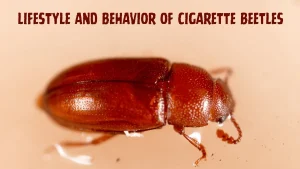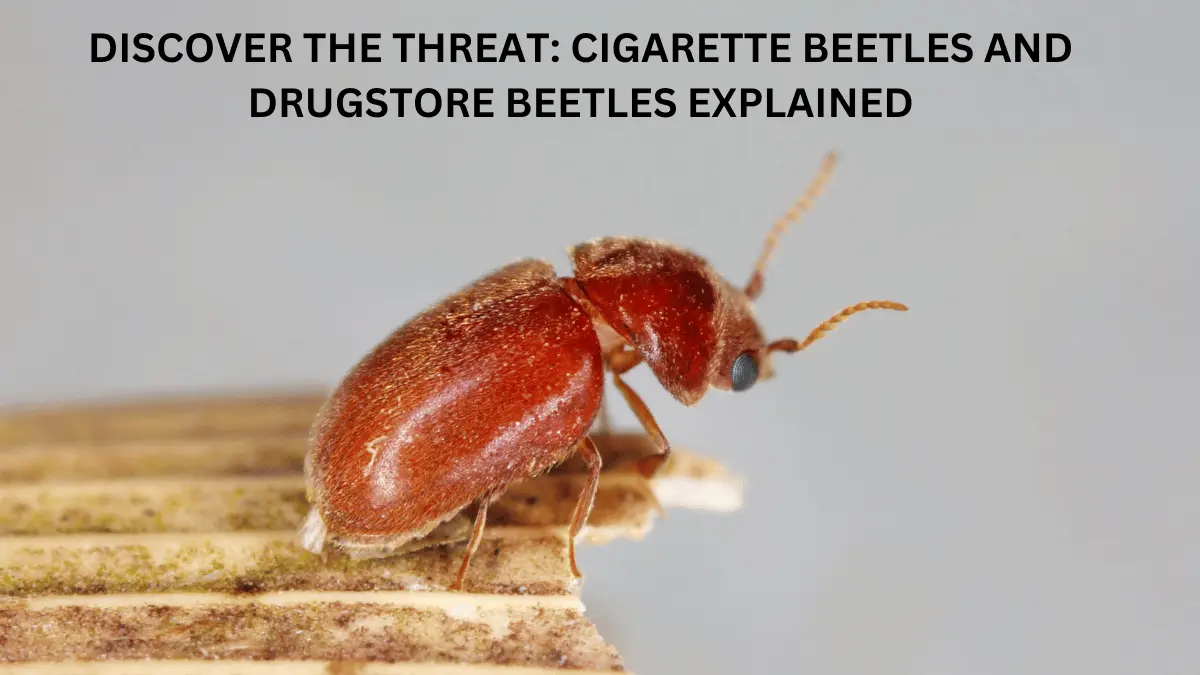The cigarette beetle, also known as Lasioderma serricorne and stored product pest, is a small but significant household pest that can cause damage to a variety of materials.
Despite its name, the cigarette beetle does not only infest tobacco goods; it can also be found in dried fruits, spices, grains, and fabrics.
Understanding this pest’s identification, behavior, and prevention strategies is critical for protecting our homes and property.
Let’s delve into the beauty of cigarette beetle!
Table of Contents
Characteristics Of The Cigarette Beetle
Cigarette beetles are little insects with grooved wings 2-3mm long.
It is reddish-brown and humped. Cigarette beetles are distinguished by their clubbed antennae with three segments.
This distinguishes it from the pharmacy beetle, which has serrated antennae.
The cigarette beetle has four stages: egg, larva, pupa, and adult.
Female beetles lay their eggs near food sources, which develop into larvae in a week.
The microscopic, white larvae feed on contaminated material for weeks before pupating.
Adult beetles live two weeks after emerging from pupae.
Where You Can Find Cigarette Beetles?
Cigarette beetles are like warm, humid areas worldwide. They are prevalent in North America, Europe, Asia, and Africa.
The taste of tobacco attracts these pests, making them common in tobacco-growing or storage regions.
Improper storage and handling of contaminated goods helps spread tobacco beetles.
They may ride infested goods to new sites. The insects also travel short distances, spreading to surrounding places.
Life Cycle Of Cigarette Beetle Lasioderma Serricorne
The Lasioderma serricorne cigarette beetle is a widespread tobacco pest. It has four stages: egg, beetle larvae, pupa, and adult.
Females can deposit 100 eggs in 6–20 days under food crevices, folds, or depressions.
Adult female beetles lay their eggs in cracks and crevices around cigarettes, cigars, and tobacco leaves. The white, 0.5-millimeter eggs are tiny.
After a week, the larvae hatch and eat tobacco.
They have a head and three legs and are tiny and yellowish-white. Larvae grow through multiple molts, and temperature and humidity affect their duration. After developing, larvae spin a cocoon and become pupae.
They metamorphose into adult beetles at this time. Adult cigarette beetles are reddish-brown, spherical, and 2–3 millimeters long.
The cigarette beetle lives for 4–10 weeks, depending on the surroundings.
Lifestyle And Behaviour

Cigarette beetles can live in many different places. They like dark, warm, and humid places.
That’s why you often see them where food and other things are kept, like pantries, storage areas, and warehouses.
Cigarette beetles mostly eat dried plants. This includes tobacco and other things like dried fruits, spices, grains, and textiles.
Beetles can smell well and are drawn to the smells that come from these things.
Cigarette beetles have made changes to help them survive and have babies.
They can chew through cardboard and plastic to get to their food.
They can go without food for a long time and wait for good conditions before coming out.
Cigarette Beetle Infestation And Economic Impact
Cigarette bottles can harm many different things. They can damage materials like tobacco, food, and textiles.
This can cause you to lose money. The beetle larvae eat the infested material, making holes and tunnels.
Food product contamination can happen, making them not good to eat.
Cigarette beetle infestations in the tobacco industry can cause whole crops or batches of tobacco products to be lost.
The beetles eat the tobacco leaves and put their eggs on them, worsening the problem.
Tobacco farmers and manufacturers may experience financial losses as a result of this.
Cigarette beetles can infest stored grains, dried fruits, and spices in the food industry.
This can cause a loss of these items. The beetles make these products unsuitable for eating by contaminating them with poop and old skin.
Food producers and distributors may experience financial losses as a result of this.
Cigarette beetles can harm fabrics and clothing kept in the textile industry.
The beetle’s larvae eat natural fibers like wool, silk, and cotton. They make holes and tunnels.
Valuable textiles and clothing items can be lost as a result of this.
How To Get Rid And Control Cigarette Beetles?
Preventing cigarette beetle infestations requires a combination of proactive measures and proper storage and handling techniques.
Here are some tips to keep cigarette beetles at bay:
Inspect Incoming Items:
When bringing new items into your home or business, inspect them for signs of infestation. Look for holes, tunnels, or any other signs of damage.
Proper Storage:
Stored tobacco, dried fruits, spices, grains, and textiles in airtight containers or packaging.
This will help prevent the beetles from accessing their food source.
Regular Cleaning:
Regularly clean and vacuum storage areas, pantries, and other areas where infested materials are stored. This will help you to remove any eggs or larvae that may be present.
Temperature Control:
Cigarette beetles thrive in warm and humid environments. Maintaining a cool and dry environment can help deter their infestation.
Pest Control Professionals:
If you suspect a cigarette beetle infestation or have had previous issues with these pests, it is advisable to seek the help of professional pest control experts.
They have the knowledge and tools to eliminate the infestation and prevent future occurrences effectively.
Are Cigarette Beetles Harmful To Humans?
Cigarette beetles may not directly harm humans, but they can still cause health risks if they are around.
Beetles don’t bite or sting. They also don’t spread diseases.
But when they are around, they can cause allergies and make breathing hard for some people.
Sensitive folks may experience allergic reactions when they come into contact with the cast skins and feces of cigarette beetles.
You might notice skin rashes, itching, and respiratory symptoms like coughing, sneezing, and wheezing.
Sometimes, people can have very bad allergic reactions.
Remember that these health risks are not very common and mostly happen to people with allergies or breathing problems.
But it is still a good idea to be careful to stop cigarette beetles from coming and make the chance of getting sick smaller.
Conclusion
To summarize, the cigarette beetle is a small but substantial home pest capable of causing harm to a wide range of materials.
Understanding its identification, behavior, and preventative strategies to secure our houses and goods is critical.
We can reduce the likelihood of cigarette beetle infestations by taking proactive steps such as proper storage and regular cleaning.
If an infestation is suspected or previous problems have occurred, it is also critical to seek the assistance of experienced pest control professionals.
By fostering the presence of natural predators, maintaining a healthy ecosystem, and supporting biodiversity, we can help manage cigarette beetle populations.
By shining a light on the tobacco beetle, we may take preventive actions to prevent infestations and protect our homes and enterprises from financial damages.
When we learn about the cigarette beetle, we can do things to stop them from coming and hurting our homes and businesses.
This will help us avoid losing money.
FAQ.s
What do cigarette beetles eat?
Cigarette beetles feed on various items, including tobacco, dried flowers, cereals, spices, pet food, and books.
How do cigarette beetles infest stored products?
Cigarette beetles can enter your home or facility through gaps, cracks, and openings. They are attracted to the scent of food and can easily find their way into packaging.
How can I prevent cigarette beetle infestations?
Prevention is key. Start by regularly inspecting stored items for signs of infestation, such as tiny holes, webbing, or beetles.
Properly seal and store susceptible products in airtight containers. Maintain cleanliness and hygiene in storage areas.
Are cigarette beetles harmful to health?
While cigarette beetles are not directly harmful to humans, their presence can contaminate food and stored items, rendering them unfit for consumption.
Can cigarette beetles fly?
Yes, adult cigarette beetles can fly short distances. However, they are more likely to crawl from one place to another.
Related Articles
Must Know About The Mealworm Beetle: Top Facts And Life Cycle
What’s That Gold Beetle? Secrets Of Charidotella Sexpunctata
Water Beetles Diving Deeper: Exploring The Survival Tactics!
